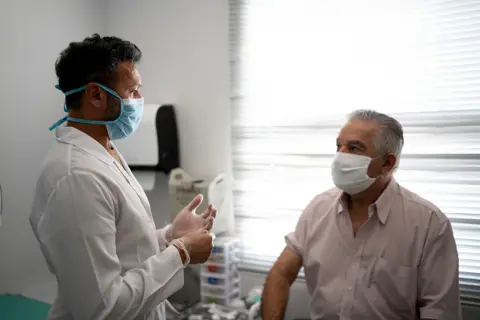
Nouf Al-Fadel
Drug Safety Section Head, Executive Directorate of Pharmacovigilance, Saudi Food and Drug authority

The challenges of the global COVID-19 immunisation effort had the pharmacovigilance team in Saudi Arabia develop some innovative tactics to ensure vaccine safety for its citizens.
The COVID-19 pandemic will go down in history as one of the most devastating pandemics ever. First identified in December 2019 in Wuhan, China, the SARS-CoV-2 virus was quickly identified as the pathogen responsible for serious respiratory distress in infected patients. The virus spread to many countries across the globe, forcing lockdowns and isolation at different levels. Public health authorities also turned to other public care strategies, such as hand washing, use of facemasks, physical distancing, and mandated travel bans to curb the outbreak. Just over a year later, vaccines from multiple pharmaceutical companies, such as Pfizer, Moderna, and AstraZeneca, were introduced as a more effective public health measure to curb the spread and catastrophic effects of the disease.
In Saudi Arabia, the first case was reported on 2 March 2020. As of 3 December 2022, 68,148,406 vaccine doses have been administered.
Vaccines are a necessary intervention in combating pandemics; however, ensuring their safety is vital. Therefore, pharmacovigilance plays an important role in monitoring the safety of COVID-19 vaccines throughout the world. In Saudi Arabia, a national pharmacovigilance plan has been in place since the beginning of the vaccination campaign in 2020.
Saudi Arabia’s active COVID-19 pharmacovigilance strategy was implemented in August 2020, following the introduction of COVID-19 vaccines. The pharmacovigilance executive directorate at Saudi Food and Drug Authority (SFDA) established a COVID-19 pharmacovigilance team, specifically focused on monitoring safety and quality of COVID-19 vaccines, including Adverse Events Following Immunisation (AEFI) monitoring and evaluation and reviewing and implementing vaccine risk minimisation measures (RMMs). Ultimately, the COVID-19 pharmacovigilance strategy in Saudi Arabia relied on passive spontaneous reporting of adverse events; and this raised some challenges, which are worth reflecting upon.

“The experience from this pandemic and COVID-19 vaccination has strengthened our pharmacovigilance system and prepared us for public health challenges that may arise in the future.”
Under-reporting in Saudi ArabiA: Under-reporting is a rather common challenge with spontaneous adverse event reporting, posing a serious challenge for safety monitoring of COVID-19 vaccines. For example, healthcare professionals may not report certain adverse events, especially if they are not sure of the causal relationship between the vaccine and the adverse event. Adverse events are also likely to be under-reported when the time to onset of event was delayed, which is common with vaccination AEFIs, and may begin long after the vaccine has been administered and where recipients may not consider the vaccine as linked to the adverse event.
Causality assessment of AEFI reports: Assessing the potential causality relationship between an adverse event and the vaccine is limited by underreporting and missing information. Certain critical information such as differential diagnosis, laboratory results, imaging findings, patients' past and present histories, and outcome of the event can help assess the causality of the adverse event.
Lack of background rate: The absence of the background incidence rate of certain AEFIs made it difficult to determine the trend of adverse events following the introduction of the COVID-19 vaccines. Without high-quality evidence and real-world data, the SFDA faced challenges to make rapid regulatory responses to some serious safety issues.
Transparency and clear communication of vaccine risks to the public: The lack of well transmitted information of vaccine risks has a lot of disadvantages. False information on vaccine risks circulate on the internet and social media and many people believe this misinformation. This can increase vaccine hesitancy and may also affect people’s reporting behaviors as they may ignore an adverse event and choose not to report it.
The public should be empowered with the right information, so they know how best to respond to adverse events. For instance, we published an official statement on the SFDA social media channels for the public about the possible risks of blood clots with the use of the Oxford/AstraZeneca vaccine following its suspension in certain European countries.
Considering the limitations of the current COVID-19 pharmacovigilance system, there are opportunities to improve it for better monitoring of the COVID-19 vaccine safety. These were the core steps taken by the SFDA to improve ours:
An active surveillance system differs significantly from a passive surveillance system as it uses real world data against voluntary reporting. Active surveillance helps mitigate the limitation of underreporting of AEFIs. Therefore, the COVID-19 pharmacovigilance team, in collaboration with the Ministry of Health, conducted an active surveillance study to measure the cumulative incidence of AEFIs of COVID-19 vaccines with different modes of action for three months after the first dose (from the first day of vaccination for seven days after the first and second doses, then biweekly for three months). The study also extended the duration of follow-up after vaccination for at least one year following immunisation.
Reporting forms were modified to be more robust and effective for collecting more information that will help assess the causality of adverse events.
Reporting lines are expanded to ensure that more AEFIs are reported. Serious cases identified are followed up to gather critical missing information for better assessment. The SFDA launched a channel of communication with the Ministry of Health, National Guard Health Affairs, and Ministry of Defence Health Affairs, in addition to the regional pharmacovigilance centres to take up this responsibility. Furthermore, members of the general public who are eligible for vaccination will now be able to submit AEFIs up to 90 days following vaccination via the Saudi Vigilance system and Sehaty application.
All reported adverse events that focus on events of serious health risks are now pooled and assessed by the SFDA causality assessment committee in a timely manner. The SFDA personnel with biologics and vaccines expertise prepare comprehensive safety reviews for valid safety signals related to COVID-19 vaccines using several evidence sources, including literature, results of causality assessment of global cases and local cases, and stringent regulatory authorities’ reviews. The SFDA Higher Pharmacovigilance Advisory Committee then conducts several meetings to extensively evaluate these reports to recommend the appropriate regulatory actions.
For healthcare professionals, the SFDA conducted several workshops and distributed educational material illustrating pharmacovigilance practices regarding vaccine safety and reporting AEFIs. The SFDA also disseminates information suitable for the general public on the vaccine safety using appropriate channels.
A rolling submission process was adopted to accelerate the approval process of COVID-19 vaccines, and the vaccine’s marketing authorisation holder is now required to submit RMMs at the time of application, such as a Healthcare Professional Guide and a Vaccine Recipient Guide. Moreover, the marketing authorisation holder is required to commit to monthly submissions of a summary safety report for 6 months following authorisation of their COVID-19 vaccine.
The SFDA joined the International Coalition of Medicines Regulatory Authorities (ICMRA) to exchange data and experiences related to AEFIs with COVID-19 vaccines. This collaboration resulted in a change in the regulators’ behaviour, at least initially, to focus on solving problems and finding ways to promote confidence in vaccine safety.
The SFDA has faced significant challenges in COVID-19 vaccine surveillance in Saudi Arabia. Therefore, the SFDA sought to strengthen the current surveillance system by adopting an active surveillance system approach and decentralising reporting channels to improve surveillance capacity. This will help to facilitate more rapid responses and help the SFDA to conduct well-informed benefit-risk assessments. The experience from this pandemic and COVID-19 vaccination has also strengthened our pharmacovigilance system and prepared us for public health challenges that may arise in the future.
Disclaimer:
The views expressed in this paper are those of the author(s) and do not necessarily reflect those of the SFDA or its stakeholders. Guaranteeing the accuracy and the validity of the data is the sole responsibility of the research team.
The annual #MedSafetyWeek campaign reminds us that medicines work best when they're safe. In Aligarh, healthcare workers came together to make that message a living reality.
19 November 2025
Since 2020, the ICPV has worked to improve drug safety reporting at Instituto Nacional de Cardiología Ignacio Chávez, with promising outcomes.
16 October 2025
Two-thirds of pharmacists in Nigeria witness weekly cough syrup abuse, yet poor reporting systems and unclear guidelines prevent effective intervention, leaving its youth at risk.
03 December 2025